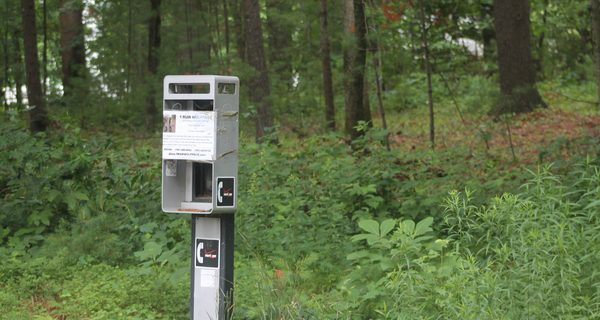While it might not look like much in the photograph, this dam is much higher and louder you would think.
By James Kinneen
Hometown Weekly Reporter
Why are people so infatuated with some obsolete technologies, but don’t care at all about others? It’s a question I think about every time I pass an estate or yard sale and see some items being tossed in the trash and others cherished as expensive collectables, or whenever I watch one of the wide variety of television shows about antique collection and appraisal and try to guess an item's worth.
And, it’s a question I pondered throughout my hike on the Caryl Trail at Noanet Woodlands, which led me to one of Dover’s abandoned mills.
When I pulled into the parking lot, the first thing I saw was a pay phone - or at least what was left of one. The steel base was there, but there was no actual phone and there were no wires it would have been plugged into. It made me weirdly sad to see what was left of this once-vital technology, because my dad worked for New England Telephone/Nynex/Bell Atlantic/Verizon throughout my childhood. He was given a beeper, and many painful hours of my life were spent trying to find a payphone for him to call people back. He also claimed that the people who collected quarters from the payphone for a living were given a test on their first day. A coin was placed in the return (think of where kids check for loose quarters in a gumball machine) and if they took the coin, they were fired for theft. That may be absolute fake news, but it was the story I grew up hearing, and was definitely a part of phone company lore.

I can understand why others wouldn’t feel any connection to pay phones, but what about mills? Southern women get married on plantations, so you can’t claim people are disturbed by their history of exploitative labor. And, if you think people don’t have an absurd love of other large buildings that are no longer necessary, think about lighthouses. People love lighthouses. People have lighthouse calendars. People will travel for hours to see a lighthouse, like it’s not going to be a tall white building with a spiral staircase and a spinning light-bulb on top. “Chronicle” has been on New England television for longer than I’ve been alive, and it has only two topics: lobster rolls and lighthouses. For whatever reason, people are obsessed with lighthouses (which haven’t mattered since the invention of sonar) and just don’t care about mills.

It's a shame, because while the building is not intact, the former home of the Dover Union Iron Mill (which apparently specialized in the metal bands placed around barrels) is neat. Right now, all that’s left is a giant dam, but at one point, the mill was home to, at 36 feet tall, the largest waterwheel in the Northeast, and possibly the country, which was made of white oak. The workers of the mill were farmers who left the farms in the winter to work in there. Unfortunately, the plaque in front of the dam informs you that “we can’t know exactly what the mill looked like,” although models have been made. It is a very interesting place, but I was the only one there on Friday, so people must not be too intrigued by it.

There’s no way of knowing what obsolete technology or industry will be forgotten, and which will be cherished in the future. But if you want to take a quick hike on the Caryl Trail, you can see the remains of one of Dover’s great industries. And, if you’re not sure where it is, don’t worry. After you hear the sound of running water, the giant brick wall dam will stick out like a lighthouse in a storm. You know, back when that was a thing.























